Gardens & Gastronomy in The Land of the Centaurs
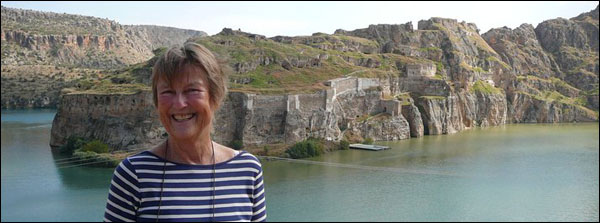
Eating Well Is The Best Revenge
By Diana Farr Louis
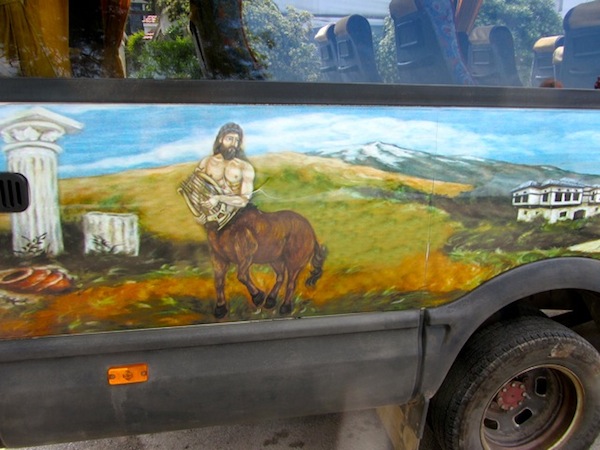
“So many years had passed since I’d been to Pelion I’d forgotten how truly magical and mythical it is. Although all of Greece is still sporting May greenery, Attica, the Peloponnese, and the Aegean islands remain much drier and barer than this water-rich mountain.”—By Diana Farr Louis
 ATHENS Greece—(WeeklyHubris)—(6/9/2014)—When you drive up and down the steep slopes of Mt. Pelion, so packed with trees you can’t see the earth, you could almost swear that some of those mysterious dark shadows beneath them belong to restless centaurs. When the earliest Greeks placed them on this hook-shaped peninsula south of Ossa and Olympus, centaurs were brutish beasts, the equine equivalent of the Minotaur, given to rape and unspeakable, drunken violence. In our day, they have morphed in our imaginations into wise and noble creatures like Chiron, the teacher of Achilles and Asclepius, the god of medicine.
ATHENS Greece—(WeeklyHubris)—(6/9/2014)—When you drive up and down the steep slopes of Mt. Pelion, so packed with trees you can’t see the earth, you could almost swear that some of those mysterious dark shadows beneath them belong to restless centaurs. When the earliest Greeks placed them on this hook-shaped peninsula south of Ossa and Olympus, centaurs were brutish beasts, the equine equivalent of the Minotaur, given to rape and unspeakable, drunken violence. In our day, they have morphed in our imaginations into wise and noble creatures like Chiron, the teacher of Achilles and Asclepius, the god of medicine.
The wise and noble version, enthusiastically nurtured in Pelion, pops up in unlikely places. It stretched the length of the minibus that ferried us members of the Mediterranean Garden Society (MGS) around last month and covered a wall opposite the War memorial at Drakeia above Volos, where a waving cherub sat on his rump.
It amused us to be traveling in the belly of a centaur but, whenever we stopped to visit gardens or inspect a cluster of hot-pink orchids or sapphire-blue salvias, we couldn’t help but notice the profusion of healing herbs, both tended and wild. Chiron would have known how to use them all; his name is even the root of the word surgeon (think French chirugien and the connection is more obvious).
So many years had passed since I’d been to Pelion I’d forgotten how truly magical and mythical it is. Although all of Greece is still sporting May greenery, Attica, the Peloponnese, and the Aegean islands remain much drier and barer than this water-rich mountain. I’d also forgotten that southern Pelion, which is less touristed than the northern half, still belongs to the land of the olive. All but one of the eleven gardens we visited had been coaxed out of groves of trees that were at least two or three hundred years old. And all but three of them existed on vertiginous slopes, planted on staggered terraces, often with mesmerizing glimpses of the sea way below.
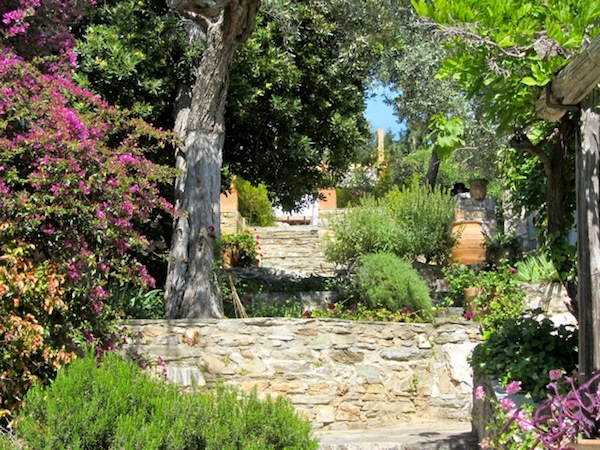
Our guide to these secret gardens, only one of which is open to the public, was Sue Wake, a British MGS member who became smitten with the area around Lafkos in 1988 and eventually moved there. Unlike most expats, she did not go to retire. Quite the opposite, she and her partnerChristian Lefaucheux set about building a hotel—no space here to recount that saga—which finally opened last December. Their Country Hotel Lagou Raxi (www.lagouraxi.com), or Hare Ridge, became our base for four very comfortable nights. Its smiling staff, beautifully finished rooms, panorama over the Pagasitic Gulf, not to mention excellent breakfasts and dinners, kept our batteries charged. As for the gardens, they are not yet mature but show great potential, and I for one paid obeisance to the rosy peonies every morning.
It is quite amazing what an effect looking at gardens seems to have on one’s appetite. Despite the ample sweets offered at our first garden, which came barely an hour after a copious lunch at a tsipouradiko—fire water and appetizers—in Volos, we showed no shame at polishing off dinner at Lagou Raxi as the sun set. Christian being French, the menu had a Gallic flavor: verrine with tomato tartar and goat cheese, savory cake with zucchini and feta, chicken with tarragon and orange honey sauce. And being a wine importer as well, his cava boasted several French and Italian wines, as well as a delicious local Merlot we became quite fond of.
On our second day, we were starving after exciting visits to two gardens. The first, carved out of a cliffside, proved a challenge even for our doughty minibus, whose driver had to negotiate the impossibly narrow rocky road down and evacuate us in order to get back up again. The owner admitted it was easier to do errands by sea—his white speedboat gleamed invitingly off the beach at the bottom of the precipice. He also said he’d “bought the property for nothing, because it was worth nothing.” It must be worth something now, at least as a gorgeous hideaway for a modern Nebuchadnezzar. The tea and cookies offered at the second “wild” garden by its English owners merely started our tummies growling, or was it the playing with the colony of stray pooches and newborn kittens that set it off? “S” had helped start PAWS, Pelion Animal Welfare Society four years ago, which finds homes abroad for abandoned dogs.
Lunch when it came was a Lucullan feast in a tiny cove called Katigiorgi, where two tavernes duel for patronage. Stamoulis’ place, Areti, had won our locals’ vote, and we could taste why. There was no menu; instead a team of waiters just brought dish after dish until we were crying for mercy. Among the goodies were stuffed squid, fried anchovies, cod fritters with garlic sauce, pepper pie, cheese pie, zucchini fritters, grilled sardines, and lots of different salads. All for a pittance, which had been arranged beforehand.
For a much needed postprandial walk, we went to another cove called Theotokou, named after a church erected on the site of an early Christian basilica built below an ancient acropolis where one of the two archaeologists among us later discovered sherds going back to the Geometric Era. We admired the bit of mosaic floor and collected bunches of wild asparagus and samphire . . . before moving on to a third garden in order to make space for supper.
Our third day began for the sure-footed with a hike down from Lafkos to Milina on the coast via a traditional kalderimi or stone path. From there walkers and laggards merged for a stroll round our second flat garden, right on the Pagasitic Gulf, where Kyria Katya—no spring chicken—was creating a sheltered sanctuary using plants she’d grown from seed or cuttings in her own nursery. Many beds had baby succulents waiting next to them in boxes, ready for transplanting after we left. She told us she worked from 6 a.m. to 9 p.m., and the very thought made us long for a rest and a bite.
That involved a scenic drive up and over the mountain to Trikeri, a big village at the southern tip of the peninsula. Our taverna, To Agnandi, was named for the extraordinary view that took in Skiathos and Skopelos, as well as the other side of the almost closed Pagasitic. And it flouted the correlation—the better the location, the worse the food. But strangely, we were so rapt in conversation that I remember little besides a huge Greek salad with tangy early tomatoes and a slab of local feta soused in exquisite local oil; we swabbed the plate dry with fresh bread still warm from the oven.
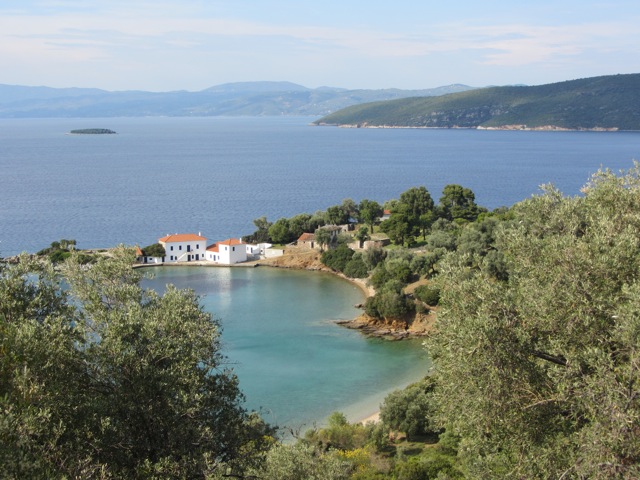
Instead of gardens, the afternoon held a lazy stroll around a second miniscule port, Agia Kyriaki, that looked like a model for a “live your myth in Greece” poster. And a guided visit to the imposing sounding Maritime and Traditional Museum which turned out to be two rooms of memorabilia and photos. We followed this with a return to Lafkos, and its unlikely claim to fame, the only radio museum in all Greece.
Though not terribly exacting activities, they left us ravenous. After freshening up at the hotel, we left Lagou Raxi and took the short walk back to Lafkos square for supper in a traditional taverna. Pelion squares are typically shaded by vast plane trees. This one had those but also an even grander cypress, the tallest and fattest I’d ever seen.
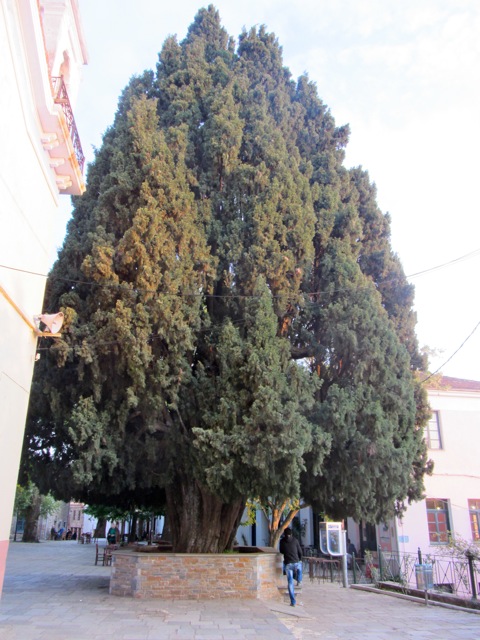
Supper consisted of a parade of traditional dishes, most notably Pelion’s signature pièce de resistance, spetsofai, piquant sausages sautéed with green peppers and tomatoes, which increases wine consumption with every bite.
Sunday morning found us back at the square, which by day was jammed with people, either sitting in café chairs under the trees or milling around at a circle of stalls, where locals were selling crafts, preserves, and plants. This was a chance to buy a jar of tsitsiravla, the pickled tendrils of a tree in the pistachio family, cinnamon scones, olive wood spoons, and seedlings of all sorts. At least half the locals were transplanted German- or English-speakers.
More gardens followed, naturally. One was in Lafkos itself, a pretty courtyard with roses, irises, salvias, and succulents making a collage of reds and mauves against a terra cotta background of brick walls and reclining Ali Baba jars. The other three were jungles in dense olive groves, where special zones had been carved out for small lily ponds, citrus orchards, exotic trees like bauhinia, jacaranda, and melia, decorative beds of annuals and perennials, fleshy succulents, flashy red amaryllis, beautiful stone terracing, sea views, and even mosaics and ceramics created by the owners.
These feasts for the eyes and noses were complemented by a picnic feast created by one of Lagou Raxi’s chefs: mixed green salad, baguette with smoked salmon, small flaky pies with fresh white cheese (anthotyro) stained pink by the addition of tomato, and raisin-studded semolina halva. It was served in the cloisters of a picturesque abandoned monastery at the end of a magnificent alley lined with pencil-straight cypresses.
In between gardens, we also took time to visit the new Milea winery. We’d already developed a more than passing acquaintance with their Merlot at dinner, so this was a good chance to buy some for our own cavas. To get there we passedthrough a field of pink orchids.
That evening, our last, our hosts at Lagou Raxi outdid themselves with a gala dinner created specially for the MGS. How did we choose between the pork filet with mustard sauce, puréed potatoes, and roasted garlic, and the grilled chicken with ratatouille and french fries? The yogurt mousse with peaches and spearmint still lingers in memory . . . despite the uncountable glasses of wine that slipped down before it arrived.
For our final day, we left the land of the olive and followed Sue Wake north along the ridge of Pelion through dense forests of chestnuts, planes, and other enormous deciduous trees that turned to larch and dark beech as we got higher. Somewhere close to Tsangarada, we stopped at Doris Schlepper’s Serpentin garden, a fairy tale place of snake motifs, old metal gates, small pools, “English type” plants, sculptures, and beach finds, barnyard fowl, and an atmosphere of pure enchantment. Climbing overgrown paths to the many levels, we felt like children discovering a new world. There was something unexpected at every turn—fat pink foxgloves, a mannequin’s lower half filled with drooping ivy, exquisite irises, extravagant clematis, a tiled fountain, a duck pond, a raspberry patch, more than 50 types of rose, even a “bee and beetle hotel” made of cleverly stacked perforated logs.
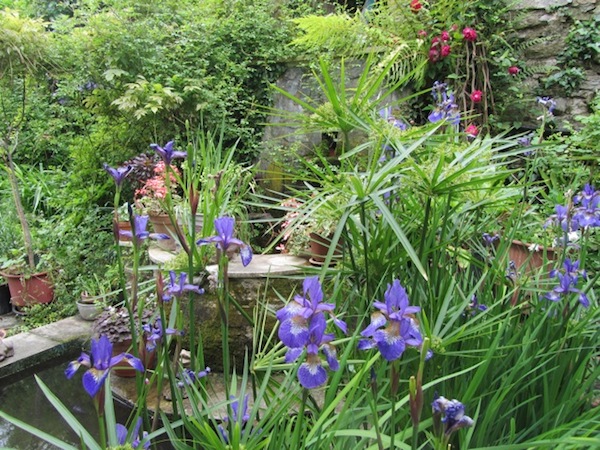
If we could have burrowed into them and stayed there ourselves, we would have. Instead, we pushed on, up past the ski slopes of Hania and down towards Volos, back into olive territory. Our last stop was Drakeia, for a visit to a steep “English” garden which boasted four donkeys and lunch under the spreading plane trees in its square. Again a parade of delicious traditional mezedes appeared one by one on the long table—spinach pies, spetsofai, red peppers stuffed with cheese, salads, dips, and a non-traditional first, devilled eggs. We tried to restrict ourselves to water, given the long drive home, but the tsipouro was already at hand. So we drank a toast to our guide, all the gardens and their gardeners, and to our group for making it a truly unforgettable five days.

RECIPE
Spetsofai
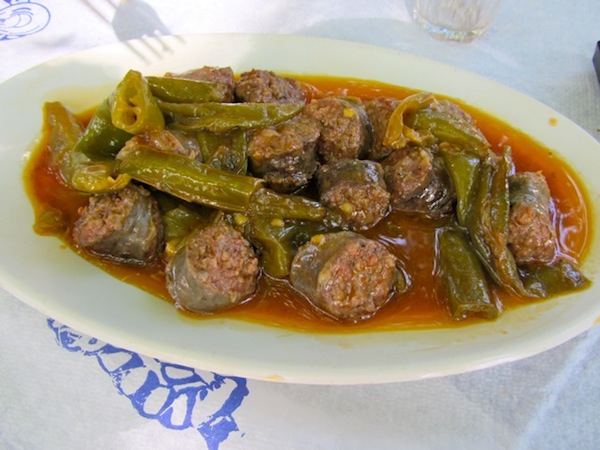
This is how I make Pelion’s famous sausage and pepper stew. It’s remarkably easy, and a great standby when you don’t really feel like cooking. Even my husband, who has no culinary pretensions, can do it superbly.
For 2 people (for more, just double everything):
Olive oil
1 large onion, thinly sliced
2 green peppers, seeded and cut in broad strips
3 tomatoes, chopped, or the equivalent canned
pinch of sugar
2 spicy country sausages, cut in thick slices
Sauté the onions and peppers in a few tablespoons of oil until soft. Add the chopped tomatoes with a pinch of sugar and simmer until their liquid has cooked down almost to the oil.
Meanwhile, brown the sausages on all sides with a minimum amount of oil in a separate pan. Add them to the vegetables, together with some of the juices from the pan and simmer for another 10 minutes until the flavors are blended.
Or, if you’re feeling lazy, just brown the sausages first and then sauté the onions and peppers in the same pan.
If the sausages are not spicy enough, I sauté a finely chopped chilli pepper along with the onion/peppers or I add a pinch of dried hot pepper flakes.

Note: For more photos and a more garden-focussed story, please go to the MGS website www.mediterraneangardensociety.org and click on international branches, Greek branch.

10 Comments
Anita Sullivan
Diana, so wonderful to hear from you again! What a magical trip, I relished every
bite (er, every garden). I can think of no better way to spend time. More! More!
Lina
It’s not often I read articles describing my country in such vivid images, smells and favors, Diana.
Your words always find their way to my heart.
Thank you!
Maria Mackavey
Diana, dear, what a charming piece! It transported me back to my visits to Pelion. It has always been a magical place for me and your Garden tour was so beautifully captured. So looking forward to seeing you later this summer. xxx
diana
Dear friends, absent and close, thanks so much for taking the trouble to write your sweet words. They mean so much. Lina, Maria, looking forward to seeing you this summer on Andros.
Will
Well, of course I had to go to the MGS site; and of course I had to examine every wonderful photo accompanying the delightful adventure. Now that is a garden tour! And I’m with Anita – I savoured every bite and sip along the way. Thank you, Diana.
diana
Will, you just have to come over and let me give you the grand tour. :-)
Angela Benbow Pullen
I’m a friend of a friend of Sue Wake (Flora Whittall) and live in the Bahamas.
Question – are you any relation of the late Bartow Farr who was married to Mary who was brought up in the Bahamas?!!
Apart from that, I loved you article on the gardens and food – quite mouth watering.
Regards, Angela Benbow Pullen
diana
Hi Angela, indeed i was related to Bartow. He was my first cousin, his father my father’s brother and my middle name is Bartow. Small world. I had no idea Mary was brought up in the Bahamas. What a coincidence. Thanks for getting in touch and your nice words.
Fern Driscoll
What a marvelous trip, Diana. Even though we finished eating not an hour ago, your descriptions of the food made me hungry all over again. Reading about the gardens just made me embarrassed for our pathetic attempts. Pelion sounds rather like Liguria: steep terraced hills, olive trees and so forth. Thank you for such a fine travelogue, I really enjoyed my vicarious garden-eating tour!
diana
hi Fern, Funnily enough, Liguria isn’t at all like Pelion and I’m trying to think why. Very different atmosphere, architecture, towns and somehow lusher, less built up. Plus no centaurs! But I do miss it. Would love to pop over and see you guys.